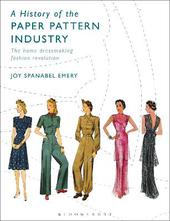
|
A History of the Paper Pattern Industry: The Home Dressmaking Fashion Revolution
Paperback / softback
Main Details
| Title |
A History of the Paper Pattern Industry: The Home Dressmaking Fashion Revolution
|
| Authors and Contributors |
By (author) Joy Spanabel Emery
|
| Physical Properties |
| Format:Paperback / softback | | Pages:272 | | Dimensions(mm): Height 246,Width 189 |
|
| Category/Genre | History of fashion |
|---|
| ISBN/Barcode |
9781350178021
|
| Classifications | Dewey:646.40709 |
|---|
| Audience | | Professional & Vocational | |
|---|
| Illustrations |
125 colour & 75 bw illus
|
|
Publishing Details |
| Publisher |
Bloomsbury Publishing PLC
|
| Imprint |
Bloomsbury Visual Arts
|
| Publication Date |
21 May 2020 |
| Publication Country |
United Kingdom
|
Description
Sewing patterns have been the principle blueprint for making garments in the home for centuries. From their origins in the tailoring manuals of the 16th century to the widely produced pamphlets of the 18th and 19th centuries, through to the full size packet patterns of today, their history and development has reflected major changes in technology (such as the advent of the sewing machine), retailing and marketing practices (the fashion periodical), and shifts in social and cultural influences. This accessible book explores this history, outlining innovations in patternmaking by the companies who produced patterns and how these reflected the fashions and demands of the market. Showcasing beautiful illustrations from original pattern pamphlets, packets and ads, as well as 9 complete patterns from which readers can reproduce vintage garments of different eras, the book provides a unique visual guide to homemade fashions as well as essential exploration of the industry that produced them.
Author Biography
Joy Emery was, until her death in 2018. Professor Emerita of Theatre and Curator of The Commercial Pattern Archive at the University of Rhode Island, USA.
ReviewsWith this volume Emery reveals important facets of American and women's history. She covers domestic and professional sewing from hand-drawn patterns to Internet- and computer-based creations [...] Her publication is profusely illustrated with 200 style and pattern drawings (mostly from period catalogs and advertisements). It features nine complete patterns, usable for readers/sewers, which cover fashion styles from 1850 to 1968. Summing Up: Recommended. Lower-level undergraduates and above; general readers. -- B. B. Chico, Regis University * CHOICE * Students of fashion and historical-costuming enthusiasts will delight in this in-depth examination of the paper sewing pattern. The evolution of the tool is examined in full, from its inception as a cutting guide for minimizing cloth waste to the fashion-forward instructions sold today [...] Home sewing has seen a resurgence of popularity in the last few years, and although this is not the book for the Pinterest populace (though browsing the illustrations is both fascinating and hilarious at turns), serious costumers and designers will appreciate the depth and breadth of information and the easy-flowing narrative of this "home dressmaking fashion revolution. -- Genevieve Grove * Booklist * It will be a springboard for students, collectors, curators and historians, and an appendix of nine patterns from 1854 to 1968 rendered for today's users will surely appeal to adventurous dressmakers. -- Barbara Burman * Costume * Emery's deep knowledge of her subject makes this book not only a crucial reference work, but also an important pointer to numerous avenues for future scholarship in this neglected area of fashion industry. -- Lindsay King, Yale University * Art Libraries Journal * [A] skilful examination of how home dressmaking changed expectations about and the means to be fashionable on a limited budget ... Well-chosen illustrations ... are an essential and well-integrated complement to the text and provide an extra layer of information on the evolution of the pattern-making industry. -- Valerie Cumming, Costume Society * Reviews in History * This is an essential book for anyone interested in vintage sewing patterns and the home sewing industry, especially anyone seeking information about the pattern companies and their dates of operation. It could be useful to vintage pattern resellers, as well, in helping to date patterns. -- Stephani Miller * Threads * The details Emery includes about the business models, innovation, and marketing of paper patterns means that this book would be of great interest to students of marketing, business, and finance as well as dress historians, home sewers, and collectors of paper ephemera. * The Journal of Dress History *
|